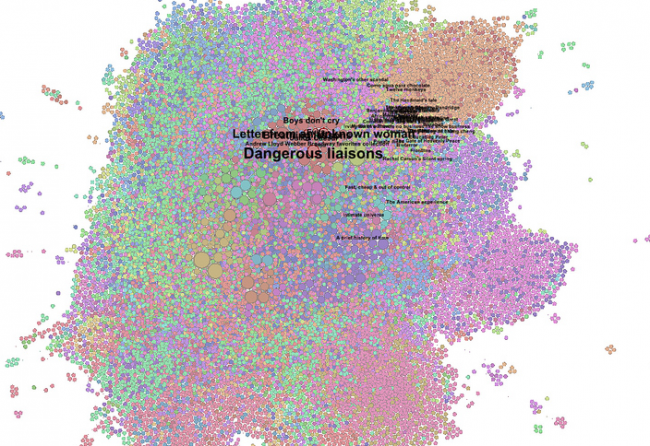A recent blogpost by Dan Brickley, a leader in the use of linked open data, has been causing quite the stir on the DPLA listserv over the past week. While the post specifically documents Brickley’s work on NoTube, a research project attempting to connect European TV content with the Web using linked open data and other Semantic Web technologies, he also discusses recent experiments in which he’s worked to open up bibliographic catalogs to the Web in the form of linked open data. The beauty of such an experiment lies in the fact that once linked, bibliographic data can then be used to understand patterns of how books and other textual objects are clustered on the Web.
Aside from generating incredible if not overwhelming data visualizations, the linking of library and other audiovisual data provides the opportunity to combine user interfaces, library-specific bibliographic data, and Semantic Web standards in such a way so as to re-define how library materials are identified, retrieved, and shared online. In an October 13 listserv response, Karen Coyle pointed out the great wealth of knowledge already at our disposal:
A big and powerful chunk of knowledge organization that is just begging for exploitation is the fact that library records have classification numbers and subject headings from thesauri. All of this could now be correlated with an analysis of the full text. It’s only another step to associate this same information with non-library materials. The classifications have the advantage of being *organized knowledge* with implicit class membership and lots of interesting sibling relationships.
Over time, as more and more linked data is generated on the Web, discernable clusters or ‘clouds’ of related ideas, concepts, individual works, historical events, and people will arise, thereby revealing meaningful relationships between materials across not only collections, but the Internet as well. In an October 15 post to the DPLA discussion listserv, David Weinberger said the current goal amongst Dan and his colleagues is to make use of enough metadata to generate semantic signatures for non-library items which they could then use to match up with the signatures of traditional bibliographic taxonomies, such as LC subject headings. In a sense, the semantic pairing of existing classification schemas with non-library objects can be considered a way of mapping the uncharted but significant avenues between materials that machines would have otherwise been unable to read. What they’re up against is nothing less than a ‘Taxonomy of Everything,’ as David Weinberger is quoted as saying in Dan’s post.
So: where might all this someday lead? Substitute the strictly television-related references for the textual/audiovisual in this quote and perhaps Dan’s NoTube project may offer a set of relevant propositions for the future of digital libraries:
What if your remote control could personalise a view of some content collection? What if it could show you similar things based on your viewing behavior, and that of others? What if you could explore the ever-growing space of TV content using simple drag-and-drop metaphors, sending items to your TV or to your friends with simple tablet-based interfaces?
